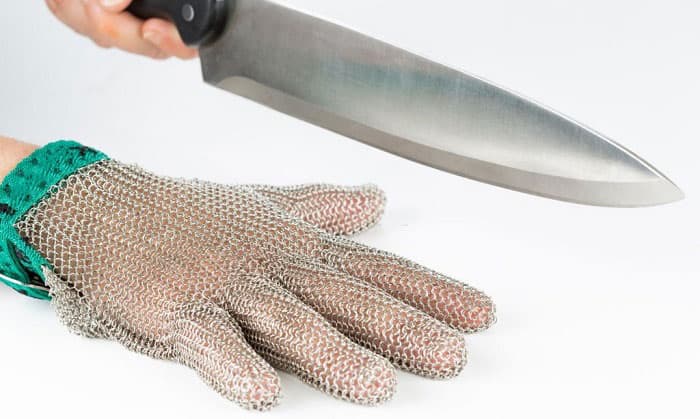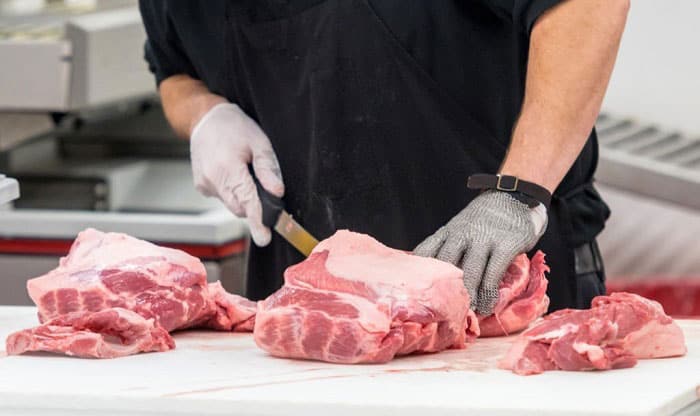If you’re wondering what are cut-resistant gloves made of, the answers vary depending on the application. They are typically classified according to the levels that indicate how tough they are against blades, heat, or chemicals to suit a wide range of jobs. Like any personal protective equipment, the gloves must comply with safety standards. At the same time, they must allow you to easily move your hands as you work.
Let’s explore the materials that manufacturers use to create them.
Table of Contents
Materials Used to Make Cut-resistant Gloves
1. Metal Mesh
Among the most durable materials, this type of gloves is produced through interlocking stainless steel rings to create an unpiercable mesh. Typically, it is sewn into a fabric, and it features a textile wristband.
Metal gloves for cutting are used by workers in meat processing and butchers for their high level of protection. With a rating of cut resistance level 5, think of this type of gloves as chainmail for your hands.
2. PolyKor Xrystal
Serving as an impenetrable barrier against sharp edges, the PolyKor Xrystal is a powerful combination of high-modulus polyethylene and mineral-based fibers.
PIP USA, the manufacturer of protective gears, claims that it is one of strongest fibers. Yet, it is very cozy to wear. Whether you are handling glass, assembling sharp parts, or working with tiles, this material can safeguard your hands.
3. Spectra Fiber
Made from polyethylene polymer, Honeywell’s Spectra Fiber is known for its strength, low lint, and lightweightedness. According to the product’s brochure, vests made of this fiber can protect the police from bullets. It is also abrasion and cut-resistant.
Aside from keeping your hands safe from sharp objects, Spectra Fiber offers comfort without losing excellent dexterity. Such gloves are available in variants with cut resistance levels from 3 to 5.
4. Dyneema
Dyneema is produced from ultra-high molecular weight polyethylene (UHMWPE). Although extremely light, this fiber is known to be 15x stronger than steel. Furthermore, it is resistant to abrasion and cut.
For gloves, the Dyneema Diamond Technology is the top choice according to Dyneema’s website. Rated level 3 to 5, this cut-resistant material gives your hands maximum comfort and allows for precise movement.
5. Kevlar
As a manufactured plastic, Kevlar is a para-aramid synthetic fiber. Its strength lies in the material’s molecular structure of many inter-chain bonds. Even under extreme heat, the fibers will not disintegrate or support combustion.
Running between levels 2 and 3, it is worth noting that Kevlar is a puncture and cut-proof material. In addition, it can catch a high-velocity projectile, such as a bullet, as well as absorb and dissipates its energy.
No wonder this fiber is used for a plethora of applications! On top of gloves, you probably have seen Kevlar on shoes and other garments worn by workers from the automotive, food, and glass manufacturing industry.
6. Polyester
Quick-drying in nature, polyester is best known for being water-resistant. However, this fabric is also abrasion and cut-resistant, which generally fall under level 3 in rating.
According to this article from Safeopedia, this cut-resistant level is apt for handling metal and assembling parts with sharp edges. It offers ample protection for workers in the manufacturing, forestry, and automotive industries.
7. Nylon
To make a strong cut-resistant fabric, the nylon is wrapped around materials like glass or steel. More notably, its fibers feel comfortable on the skin. As pointed out in this article on Stauffer, it makes for amazingly lightweight and elastic gloves.
At level 3 in terms of cut resistance, nylon gloves are strongly recommended for jobs that require maximum dexterity. Workers at electronic operations, for instance, will like this protective garment as they get protection and still have tactile sensation when pressing buttons and dials.
Conclusion
I hope that you are satisfied with my answers to the question, “What are cut-resistant gloves made of?” Indeed, there are many other materials that can make gloves protective. However, the fabrics and fibers I shared above are the most popular ones.
Here are some tips on how to select the gloves that are comfortable and appropriate for your needs:
- Familiarize yourself with the company’s safety standards
- Choose a material that meets the cut-resistant level requirements
- Measure your hands to make sure the gloves fit well

Veronica is our content editor. She is a talent in delivery. Her main work is editing and writing articles that are both informative and simple to follow. She is in charge of synthesizing our understanding of what personal protection equipment (PPE) is needed in each job, how to best apply it, and how to visualize that equipment.



